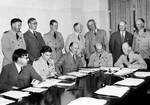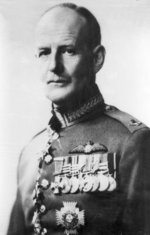Charles Burnett
| Surname | Burnett |
| Given Name | Charles |
| Born | 3 Apr 1882 |
| Died | 9 Apr 1945 |
| Country | Australia, United Kingdom |
| Category | Military-Air |
| Gender | Male |
Contributor: C. Peter Chen
ww2dbaseCharles Stuart Burnett was born in Minnesota, United States in 1882 to John Alexander Burnett (ethnically Scottish) and Charlotte Susan Burnett. He was educated at the Bedford School in Bedfordshire, England, United Kingdom. In 1899, he enlisted as a private in the Imperial Yeomanry, lying on the application to claim that he was 18 years of age. With th Yeomanry, he fought in the Second Boer War. In 1901, he was discharged so that he could be commissioned as a second lieutenant with the Highland Light Infantry regiment. He was then attached to the Imperial Yeomanry until 1904. Between 1902 and 1903, he held the temporary rank of lieutenant. In 1904, he was seconded to the West African Frontier Force, with which unit he saw action in Northern Nigeria Protectorate through 1908; he was promoted to the permanent rank of lieutenant while with the West African Frontier Force. In Sep 1909, he resigned his commission. He tried his hand running a shop in Portuguese Guinea, but he was not successful. In 1911, he was employed by the British diplomatic service as the assistant resident in Ilorin, Southern Nigeria Protectorate. When WW1 began in 1914, Burnett rejoined the British Army. In Nov 1914, he qualified as a pilot. He married Sybil Pack-Beresford in early 1915; they would have four daughters. With the temporary rank of captain, he was assigned to the Royal Flying Corps as a wing adjutant. In May 1915, he was posted as a flight commander with No. 17 Squadron; with that unit he would fly B.E.2c biplanes out of Gosport in southern England and then out of Egypt. In Apr 1916, he was given the temporary rank of major to command No. 36 Squadron based in Cramlington in northern England. In Oct 1916, he was promoted to the rank of captain, and then was sent to France to command No. 12 Squadron. In Oct 1917, he was promoted to the temporary rank of lieutenant colonel and was given command of the Fifth Wing based of out Palestine; for his leadership in the victorious Dec 1917 Battle of Jerusalem, he was awarded the Distinguished Service Order. In 1919, he was made a Commander of the Order of the British Empire. Later in the same year, now in the newly established Royal Air Force, he was promoted to the temporary rank of brigadier general to take command of the Palestine Brigade. In late 1919, he was made a wing commander. In Apr 1920, he was given command of the Mesopotamian Wing. When the wing was expanded into a group, he worked as a staff officer at the group's headquarters. Between Feb and Oct 1921, he was a supernumerary at Middle East Area Headquarters and later with No. 7 Group. In Oct 1921, he was given command of No. 29 Group In Apr 1922, he was made the station commander of RAF Leuchars in southeastern Scotland, United Kingdom. In Dec 1922, he was a supernumerary at the RAF Depot. Between 1923 and early 1927, he served as the Deputy Director of Operations and Intelligence at the Air Ministry. In 1927, he was made a Companion of the Bath. He was then made the Commandant of the Central Flying School, serving in that role until Jan 1929. Between 1929 and 1930, at the rank of air commodore, he served in Iraq as the Senior Air Staff Officer at the Iraq Command Headquarters. In early 1931, he returned to the United Kingdom to serve, concurrently, as the Deputy Chief of the Air Staff and Director of Operations and Intelligence. In Jul 1932, he was promoted to the rank of air vice-marshal. In Nov 1932, he was made the Air Officer Commanding of Iraq Command. In early 1935, he was given command of the RAF Inland Area in Britain. In early 1936, he was promoted to the rank of air marshal and was made a Knight Commander of the Order of the Bath. Later in the same year, the RAF Inland Area was converted into the RAF Training Command; Burnett remained the commanding officer of the newly reorganized unit. In Jul 1939, he was given the concurrent duty of Inspector-General of the RAF. In Aug 1939, he served as a member of the British military mission to the Soviet Union.
ww2dbaseWhen the European War of WW2 broke out in Sep 1939, Burnett remained the Inspector-General of the RAF until 1940, when he was made the Chief of the Air Staff of the Royal Australian Air Force, which came with a promotion to the temporary rank of air chief marshal. Although his appointment was fully supported by Australian Prime Minister Robert Menzies, the fact that a British officer was chosen to head the Australian air force was controversial and was resented by many RAAF senior officers. Burnett oversaw the expansion of the RAAF from 3,489 men in 1939 to 79,074 men in May 1942. A large number of the newly trained RAAF personnel were trained specifically for service with the Royal Air Force. He also worked to expand the size of RAAF's air fleet, and to establish the Women's Auxiliary Australian Air Force and RAAF health services. In early 1942, he suggested the abolition of the Australian Air Board, which put him at odds with Australian politician and minister for air Arthur Drakeford. At the same time, Burnett's loyalty to Britain was blamed for the RAAF's inability to counter Japan in the newly started Pacific War. In May 1942, he was sacked and was replaced by Air Vice Marshal George Jones, an Australian. He returned to Britain and retired from the RAF, but by 1943 he was again employed by the RAF as the Commandant of the Central Command of Air Training Corps. In Apr 1945, while still serving with the ATC, he passed away from a coronary thrombosis at the Princess Mary Hospital at RAF Halton.
ww2dbaseSource: Wikipedia
Last Major Revision: Apr 2018
Charles Burnett Interactive Map
Photographs
 |  |
Charles Burnett Timeline
| 3 Apr 1882 | Charles Burnett was born in Browns Valley, Minnesota, United States. |
| 26 Apr 1902 | Charles Burnett was promoted to the temporary rank of lieutenant. |
| 7 Feb 1903 | Charles Burnett was relieved of his temporary rank of lieutenant. |
| 20 Aug 1904 | Charles Burnett was seconded to the West African Frontier Force. |
| 4 Dec 1914 | Charles Burnett was promoted to the rank of lieutenant. |
| 2 Apr 1916 | Charles Burnett was promoted to the temporary rank of major and was made the commanding officer of No. 36 Squadron. |
| 1 Oct 1916 | Charles Burnett was promoted to the rank of captain. |
| 8 Oct 1917 | Charles Burnett was promoted to the temporary rank of lieutenant colonel. |
| 9 Apr 1945 | Charles Burnett passed away from a coronary thrombosis at the Princess Mary Hospital at RAF Halton, Buckinghamshire, England, United Kingdom. |
Please consider supporting us on Patreon. Even $1 per month will go a long way! Thank you. Please help us spread the word: Stay updated with WW2DB: |

- » Evergreen Museum and Obon Society Working on Returning Undelivered 1945 Mail to Japanese Families (5 Sep 2025)
- » Wreck of Teruzuki Found (27 Jul 2025)
- » USS Orlean's Bow Found (22 Jul 2025)
- » The Emperor of Japan Planned to Honor WW2-era Japanese POWs in Mongolia (4 Jul 2025)
- » US State Lawmaker John Winter Caught Using Racial Slur "Jap" and Apologized (11 Jun 2025)
- » See all news
- » 1,183 biographies
- » 337 events
- » 45,131 timeline entries
- » 1,249 ships
- » 350 aircraft models
- » 207 vehicle models
- » 376 weapon models
- » 123 historical documents
- » 261 facilities
- » 471 book reviews
- » 28,438 photos
- » 365 maps
Thomas Dodd, late 1945